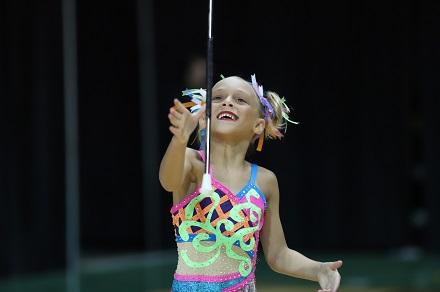
The United States Twirling Association (USTA) is a national, nonprofit youth sports organization created in 1958 and dedicated to positive youth development through the sport of baton twirling. USTA serves a national membership of athletes, parents, coaches, studio directors, competition directors, judges and other twirling supporters through a wide range of recreational, educational and competitive programs.
As the nation’s leading sport baton twirling organization, USTA has developed educational programs for recreational and competitive athletes, as well as comprehensive training and certification programs for coaches and judges.
USTA sanctions approximately 200 local, state and regional twirling clinics and competitions each year, giving athletes the opportunity to improve their twirling skills and compete in an atmosphere of fun, friendship and good sportsmanship. Each summer, USTA holds the
 Championships
Championships
As the official United States representative to the World Baton Twirling Federation (WBTF), USTA participates in the WBTF International Cup competition and holds the U.S. Trials competition to select athletes to compete in the WBTF World Championships.
Sports Destination Management: The USTA is more than 60 years old. How has the landscape of the sport changed in all that time?
Karen Cammer: The sport has advanced and become much more athletic. What our athletes can do now is just breathtaking, particularly compared to back in the 1950s and 60s.
SDM: Has the number of children involved in the sport changed?
Cammer: It has. When the USTA was formed, twirling was very big among girls – they’re still our largest demographic – but back then, there weren’t as many options for them. They could basically dance, twirl or play the piano. Today, there are many more choices for girls in sports and they usually want to do whatever it is their friends are doing. I would equate it to the way other sports go up and down. For example, it used to be that the tall, athletically talented girls all went into basketball but now we see them also being very interested in volleyball.
 SDM: Any idea how many are involved in baton twirling nationwide?
SDM: Any idea how many are involved in baton twirling nationwide?
Cammer: I would say between 50,000 and 70,000 and that includes anyone who is twirling a baton or who represents themself as a majorette.
SDM: Is there a college future for baton twirlers?
Cammer: The USTA takes a very athletic approach to the sport. As a result, we’d like to see athletic scholarships for twirlers but the fact is that most of the scholarships out there are from music departments because baton twirling is usually a part of band fronts. And there is some good money in college twirling but it is highly competitive.
SDM: Are there schools that are known for baton twirling, or where those athletes tend to gravitate?
Cammer: There are more opportunities for baton twirlers in big football schools; for example, the University of Arizona has a multi-member twirling line.
SDM: How old are kids who get into baton twirling?
Cammer: We begin with toddlers, but I would say the average age to start is seven or eight.
 SDM: Shifting gears, let’s talk about the events that you sanction.
SDM: Shifting gears, let’s talk about the events that you sanction.
Cammer: We host the National Championships and the international qualifiers in July. We also put on the U.S. Team Trials. We are hoping we’ll be able to do that this coming March; we generally host them every other March. There are also five regions within USTA, and within those there are 27 councils. The councils put on their state championships every spring, and the five regions put on Regionals every June.
SDM: What are you looking for when you’re hosting events? Obviously, you want a venue with column-free space and a high ceiling.
Cammer: With the National Team Trials, we try to find a location in the center of the country, such as Ohio or Indiana. When we host the international events, we try to go to tourist attraction locations like Disney because that’s always a big draw. In general, we’re looking for a place that is convenient to where there is a local participation, someplace with a good airport and a number of hotels. We’re also looking for a way to partner with a local destination so that we don’t have to pass on too many expenses to our participants. We like going back to cities where we’ve built up a relationship, like Stockton, Daytona Beach and Fairborn, Ohio.
SDM: Is there an age range for baton twirling?
Cammer: Well, it used to be that you stopped at the age of 18 because competition stopped then. As a result, a lot of people went into coaching or judging after that. But now, you can stay in with no age limit. We have some competitors who are in their thirties.
 SDM: What other sports do twirling athletes tend to be involved in?
SDM: What other sports do twirling athletes tend to be involved in?
Cammer: There isn’t really one particular sport, but our athletes are incredibly strong because most of them cross-train. Some, for example, have trained in track and field to work on their stamina, and some are involved with gymnastics to work on their flexibility. It depends on what they’re trying to achieve.
SDM: Will we see baton twirling in the Olympics?
Cammer: About 30 years ago, we considered trying to see if we could get acceptance through other sports, but it really wasn’t a good marriage. Right now, we believe we are about two years out from getting acceptance into GAISF (Global Association of International Sports Federations) through the World Baton Twirling Federation. Once we get that, I expect the sport will explode again.
SDM: Is the U.S. the global leader in baton twirling?
Cammer: We used to be the ruling power! Our outstanding coaches helped Japan with training and set up their own association. Today, Japan has approximately 18,000 members who are twirling and are one of the leaders in the sport. There are also strong baton twirling federations in Canada and Europe.
SDM: USTA has extensive certification programs for coaching and judging.
Cammer: We do – those are very strong educational programs. We have two levels of certifications for coaches, depending upon whether they’re coaching athletes who are beginners, or those who are more advanced, and we have three levels of judging certification, as well as a Master Judge certification. We are considered the elite in terms of those programs. Our philosophy has always been that the safety of the athlete comes first. Training and education in coaching ensures that happens and is the priority.

 www.ustwirling.com
www.ustwirling.com